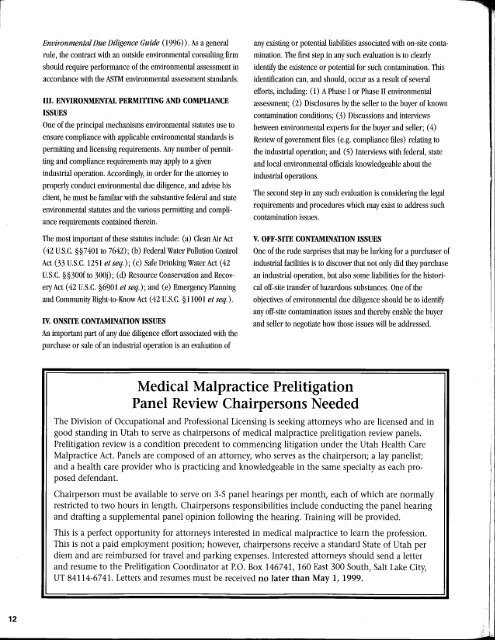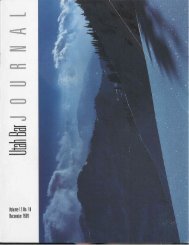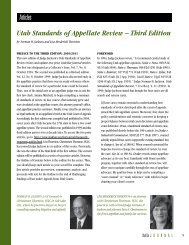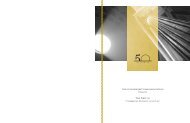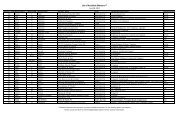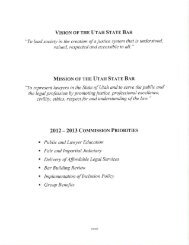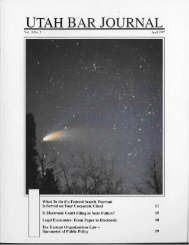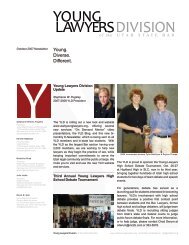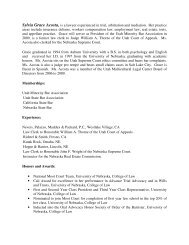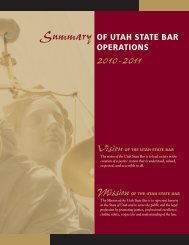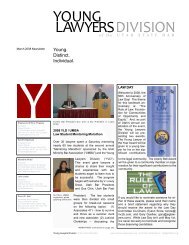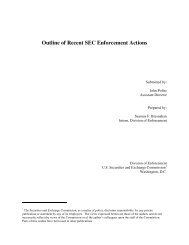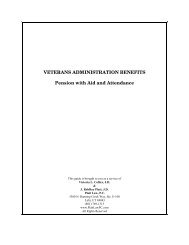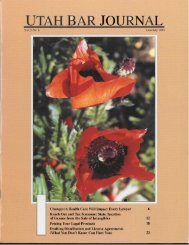March 1999 Volune 12 No3 - Utah State Bar
March 1999 Volune 12 No3 - Utah State Bar
March 1999 Volune 12 No3 - Utah State Bar
Create successful ePaper yourself
Turn your PDF publications into a flip-book with our unique Google optimized e-Paper software.
<strong>12</strong><br />
Environmental Due Diligence Guide (1996)). As a general<br />
rule, the contract with an outside environmental consulting firm<br />
should require performance of the environmental assessment in<br />
accordance with the ASTM environmental assessment standards.<br />
II. ENVIRONMENTAL PERMITlING AND COMPLIACE<br />
ISSUES<br />
One of the principal mechanisms environmental statutes use to<br />
ensure compliance with applicable environmental standards is<br />
permitting and licensing requirements. Any number of permit-<br />
ting and compliance requirements may apply to a given<br />
industrial operation. Accordingly, in order for the attorney to<br />
properly conduct environmental due dilgence, and advise his<br />
client, he must be famar with the substantive federal and state<br />
environmental statutes and the various permitting and compli-<br />
ance requirements contained therein.<br />
The most important of these statutes include: (a) Clean Air Act<br />
(42 u.S.C. §§7401 to 7642); (b) Federal Water Pollution Control<br />
Act (33 U.S.C. <strong>12</strong>51 et seq.); (c) Safe Drinking Water Act (42<br />
U.S.C. §§300f to 300j); (d) Resource Conservation and Recovery<br />
Act (42 U.S.C. §6901 et seq.); and (e) Emergency Plannig<br />
and Community Right-to-Know Act (42 U.S.C. §1100l et seq.).<br />
IV. ONSITE CONTAMINATION ISSUES<br />
An important part of any due dilgence effort associated with the<br />
purchase or sale of an industrial operation is an evaluation of<br />
any existing or potential liabilties associated with on-site conta-<br />
mination. The first step in any such evaluation is to clearly<br />
identif the existence or potential for such contamnation. This<br />
identifcation can, and should, occur as a result of several<br />
efforts, includig: (1) A phase I or Phase II environmental<br />
assessment; (2) Disclosures by the seller to the buyer of known<br />
contamination conditions; (3) Discussions and interviews<br />
between environmental experts for the buyer and seller; (4)<br />
Review of government fies (e.g. compliance fies) relating to<br />
the industrial operation; and (5) Interviews with federal, state<br />
and local environmental offcials knowledgeable about the<br />
industrial operations.<br />
The second step in any such evaluation is considering the legal<br />
requirements and procedures which may exist to address such<br />
contamiation issues.<br />
V. OFF-SITE CONTAMINATION ISSUES<br />
One of the rude surprises that may be lurkig for a purchaser of<br />
industrial facilties is to discover that not only did they purchase<br />
an industrial operation, but also some liabilties for the histori-<br />
cal off-site transfer of hazardous substances. One of the<br />
objectives of environmental due dilgence should be to identif<br />
any off-site contamination issues and thereby enable the buyer<br />
and seller to negotiate how those issues wil be addressed.<br />
Medical Malpractice Prelitigation<br />
Panel Review Chairpersons Needed<br />
The Division of Occupational and Professional Licensing is seeking attorneys who are licensed and in<br />
good standing in <strong>Utah</strong> to serve as chairpersons of medical malpractice prelitigation review panels.<br />
Prelitigation review is a condition precedent to commencing litigation under the <strong>Utah</strong> Health Care<br />
Malpractice Act. Panels are composed of an attorney, who serves as the chairperson; a lay panelist;<br />
and a health care provider who is practicing and knowledgeable in the same specialty as each proposed<br />
defendant.<br />
Chairperson must be available to serve on 3-5 panel hearings per month, each of which are normally<br />
restricted to two hours in length. Chairpersons responsibilties include conducting the panel hearing<br />
and drafting a supplemental panel opinion following the hearing. Training wil be provided.<br />
This is a perfect opportunity for attorneys interested in medical malpractice to learn the profession.<br />
This is not a paid employment position; however, chairpersons receive a standard <strong>State</strong> of <strong>Utah</strong> per<br />
diem and are reimbursed for travel and parking expenses. Interested attorneys should send a letter<br />
and resume to the Prelitigation Coordinator at P.O. Box 146741, 160 East 300 South, Salt Lake City,<br />
UT 84114-6741. Letters and resumes must be received no later than May I, <strong>1999</strong>.<br />
¡I<br />
.1<br />
~<br />
I


